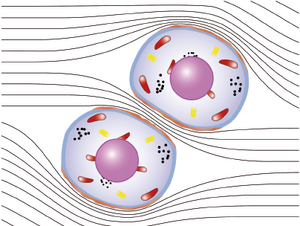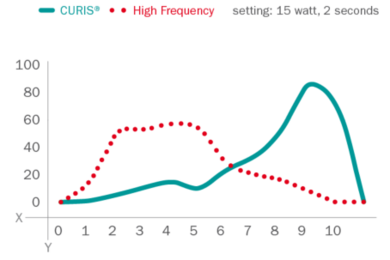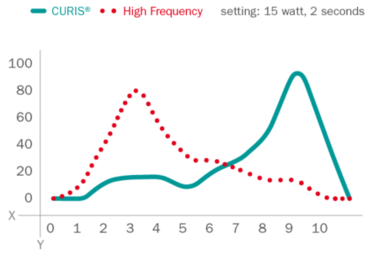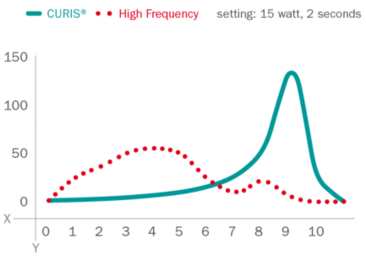Advantages of the Impedance-Controlled 4 MHz Radiofrequency Technology
Radiofrequency has found its place as a precision tool in ENT, neurosurgery and microsurgery. Numerous studies1-7 show the advantages of the 4 MHz radiofrequency technology in comparison to other technologies. With the impedance-controlled CURIS 4 MHz radiofrequency generator, Sutter offers the benefits of an advanced 4 MHz radiofrequency technology for a variety of applications*.
; height: auto; },
(min-width: 501px) { src: url(https://www.sutter-usa.com/chameleon/mediapool/thumbs/0/bf/4hz-radiofrequency-technology-blog-banner_800x352-ID5483-9e0e12e53f587947cd739faea56776c3.jpg?ck=28fe795a); height: auto; },
(min-width: 801px) { src: url(https://www.sutter-usa.com/chameleon/mediapool/thumbs/0/bf/4hz-radiofrequency-technology-blog-banner_1800x791-ID5483-e98db8df0f5cef3ecbb007859e5a2875.jpg?ck=28fe795a); height: auto; }
)
The advantages of the impedance-controlled 4 MHz radiofrequency technology lie in its physics
Using the CURIS 4 MHz radiofrequency generator energy is absorbed evenly inside the cells avoiding the energy to heat up the outer layer as it happens during conventional high frequency technology8. This even flow of energy inside the cells makes the CURIS 4 MHz radiofrequency generator an optimal tool for both cutting and coagulation in precision electrosurgery.
CURIS 4 MHz Radiofrequency Generator
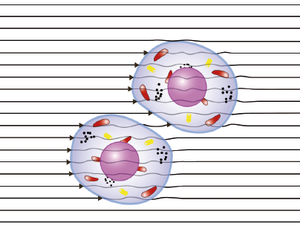
Fig. 1b: With the CURIS 4 MHz radiofrequency generator, cell membranes are conductive and the energy is absorbed evenly inside the cells. The results are highly focussed tissue effects. Illustration only.
“Using radiofrequency for dissection compared to other instruments is clearly superior. It shows better hemostasis, better handling, better cutting and it is an inexpensive treatment compared to laser.“
Clemens Heiser, MD, Munich (Germany)
Minimal Lateral Thermal Damage
Studies support the conclusion that the impedance-controlled 4 MHz radiofrequency technology produces less lateral thermal damage than other technologies:
It was shown that the CURIS 4 MHz radiofrequency generator achieved the best cutting width (see fig. 2), the smallest coagulation defects and the narrowest lesions at all energy levels compared to CO2 laser, YAG laser and high frequency technology. Moreover, it produced the smallest coagulation zone in different tissue types at various energy levels compared to the other technologies (see fig. 3a & 3b). Thus, the impedance-controlled 4 MHz radiofrequency technology preserves best the tumor-adjacent structures and improves pathological assessment.4
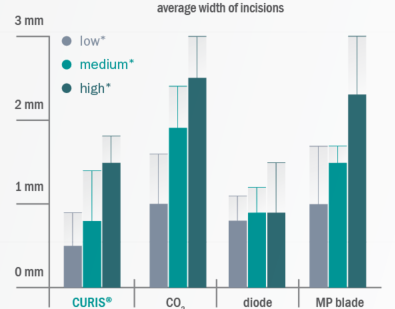
Fig. 2: Comparing the average width of incisions produced by different instruments at different energy levels
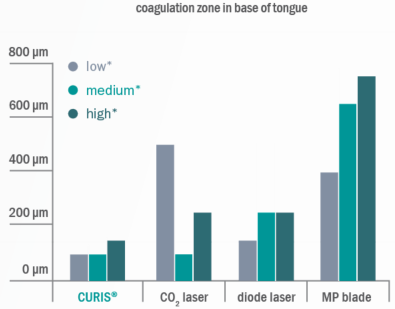
Fig. 3a: Comparing the coagulation zone of the instrument in the base of tongue at different energy levels
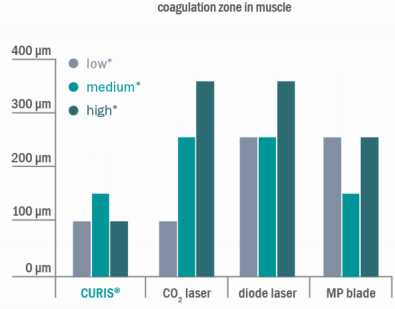
Fig. 3b: Comparing the coagulation zone of the instrument in muscle tissue at different energy levels
*energy level
Another study among 25 patients presenting with oral or oropharyngeal tumors showed that radiofrequency-assisted resected specimen using the CURIS 4 MHz radiofrequency generator were better assessable than laser-assisted resected specimen. The impedance-controlled 4 MHz radiofrequency technology produced predominantly smooth resection margins and reduced the tissue resistance. Compared to CO2 laser and high frequency technology, the 4 MHz radiofrequency technology caused the narrowest lesions and coagulation zones.5
Better Wound Healing
A comparison of the healing process of lesions in albino rats created by different technologies showed proven benefits of the 4 MHz radiofrequency technology in terms of wound healing. Using the impedancecontrolled CURIS 4 MHz radiofrequency generator turned out to be more targeted and precise compared to conventional high frequency, preserving the basal membrane as well as the deep layers of the epithelium, thus causing less profound wounds.6 The histological assessment also showed that wound healing using the CURIS 4 MHz radiofrequency generator is faster compared to conventional high frequency. Radiofrequency induced wounds show complete epithelialization after seven days in contrast to the lesions produced by high frequency which show abundant inflammation associated with focal suppurations (see fig. 4).
Radiofrequency
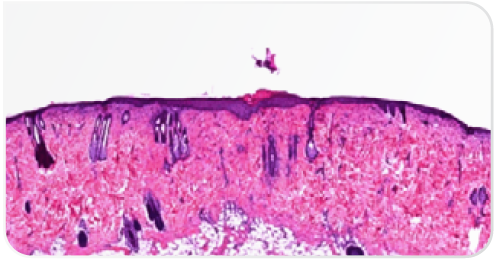
High frequency / electric cauterization
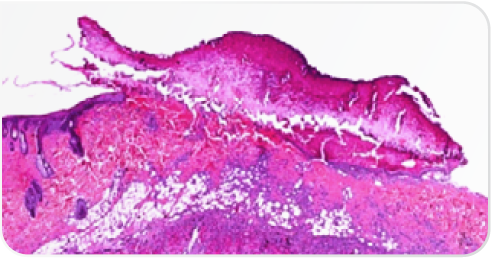
Fig. 4: Histological aspects on day seven: comparing radiofrequency and conventional high frequency
Precise Coagulation and Gentle Tissue Effects
The precision and quality of coagulation results can be observed in the effects on the tissue. A study comparing bipolar coagulations on egg yolk showed that the impedance-controlled CURIS 4 MHz radiofrequency generator achieves gentler effects as well as more reproducible results compared to conventional high frequency. With each of the two generators, 100 coagulations were performed for 1, 2 and 3 seconds, respectively. The results were evaluated by three blinded analysts on a visual analog scale for three criteria: edge sharpness, homogeneity and shape of the coagulation (see fig. 5 & 6).9
Conventional High Frequency Generator
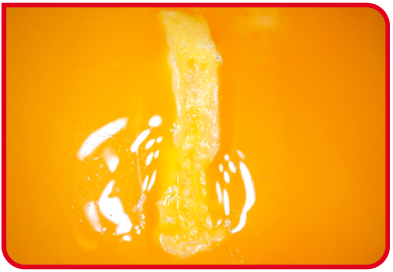
Fig. 5: An example of poor shape of coagulation,
poor edge sharpness and poor homogeneity
CURIS 4 MHz Radiofrequency Generator
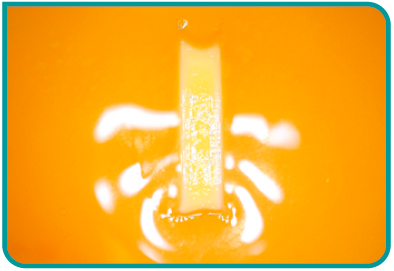
Fig. 6: An example of good shape of coagulation,
good edge sharpness and good homogeneity
The evaluations revealed a clear difference between the two generators. Overall, the impedancecontrolled CURIS 4 MHz radiofrequency generator produced better results in terms of edge sharpness, homogeneity and shape of coagulation compared to conventional high frequency. The coagulations produced by the CURIS 4 MHz radiofrequency generator were evaluated in excellent range whereas the coagulations produced by the conventional high frequency generator were much less favorable (see fig. 7-9). Since all three criteria achieved better results using 4 MHz radiofrequency technology, it can be concluded that the impedance-controlled CURIS 4 MHz radiofrequency generator leads to gentler tissue effects.9
X: Evaluation on a visual analog scale from 0 (“very poor”) to 10 (“excellent”)
Y: Number of evaluations
“The CURIS 4 MHz radiofrequency generator provides unparalleled precision to the neurosurgeon seeking optimal control in neurosurgical cases. I found the ability to perform pinpoint coagulation with minimal thermal and electrical spread increasing the safety and efficacy of my operations.”
Ali Zomorodi, MD, Durham, NC (USA)
Focused Coagulation at Low Temperatures
Interstitial Application of Bipolar Energy
A comparison of the impedance-controlled 4 MHz radiofrequency technology with Coblation (operating at a frequency of 100.1 kHz, a factor 40 times smaller than CURIS) proves the thermal benefits of 4 MHz radiofrequency during coagulation. Whereas Coblation reached excessive temperatures after saline injection*1, mean temperatures using the impedance-controlled CURIS 4 MHz radiofrequency generator did not exceed the level of 100°C (see fig. 10). These thermal advantages make the impedancecontrolled CURIS 4 MHz radiofrequency generator the more suitable technology for the treatment of hypertrophic turbinates.7
; height: auto; },
(min-width: 501px) { src: url(https://www.sutter-usa.com/chameleon/mediapool/thumbs/8/57/Fig-10-mean-temperatures-curis-ravor_800x273-ID5462-a22b6866ba3b2e228cf4bb4eb7e1fca3.png); height: auto; },
(min-width: 801px) { src: url(https://www.sutter-usa.com/chameleon/mediapool/8/57/fig-10-mean-temperatures-curis-ravor_id5462.png); height: auto; }
)
Fig. 10: Mean temperatures (°C) of a series of measurements using CURIS with RaVoR bipolar electrode and Coblation*2
*1 according to manufacturer‘s guidelines saline gel has to be used during the procedure
*2 illustration graphically modified for clarity
Additional Advantages of the Impedance-Controlled CURIS 4 MHz Radiofrequency Generator
AutoRF

AutoRF is a smart impedance control function that adapts the power output of the CURIS 4 MHz radiofrequency generator to the tissue condition. Whether it is cutting through different types of tissue (such as mucosa, muscle, fat or connective tissue) or altering tissue conditions during coagulation, the AutoRF feature delivers adapted power output as required by the different tissue impedance.
p3, which stands for pulsed power performance, is active in all coagulation modes of the CURIS 4 MHz radiofrequency generator. Radiofrequency energy is delivered in about 50 small packages per second. Due to the pulsed power output, there are short breaks between the individual packages, giving the tissue enough time to absorb the energy. Highly focused, yet gentle coagulation with minimal thermal damage is possible.
*DISCLAMER: Some of the indications mentioned in this article may not be covered by regulatory clearance of the products in the USA or other countries. Please refer to the Instructions for Use and the User Manual for more information on the intended use and indications for use in your country.
References
1 Bran, G M et al. Bipolar Radiofrequency Volumetric Tissue Reduction of Inferior Turbinates: Evaluation of Short-Term Efficacy in a Prospective, Randomized, Single-Blinded, Placebo-
Controlled Crossover Trial. Eur Arch Otorhinolaryngol, 2012.
2 Neumann, K et al. Behandlung der kindlichen symptomatischen Tonsillenhyperplasie - Radiofrequenztonsillotomie als Mittel der
Wahl. HNO-Abstractband, Dt HNO-Kongress München, 2009, p. 186.
3 Pang, K P Siow, J K. Sutter Bipolar Radiofrequency Volumetric Tissue Reduction of Palate for Snoring and Mild Obstructive
Sleep Apnoea: Is One Treatment Adequate? J Laryngology and Otology, V 123, 2009, p. 750-754.
4 Hoffmann TK et al. Comparative analysis of resection tools suited for transoral robot-assisted
surgery. Eur Arch Otorhinolaryngol 2014; 271:1207-13.
5 Hofauer B et al. Radiofrequency in Oral and oropharyngeal tumor surgery. Auris Nasur Larynx, 2020; 47(1):148 - 153.
6 Muehlfay G et al. A study of the type of lesions achieved by three electrosurgical methods and their way of healing. Rom J Morphol Embryol, 2015.
7 Vogt K et al. Comparison of the thermal effects of Coblation and Radiofrequency waves in a porcine turbinate model. Romanian Journal of Rhinology, 2018.
8 Holder, D S “Brief introduction to Bioimpedance” in: Electrical Impedance Tomography–Methods, History and Applications. IOP Publishing Ltd 2005.
9 Sutter Medizintechnik, data on file, 2019.
10 Sutter Medizintechnik, data on file, 2020.
11 Basterra J et al. Transoral Resection of Supraglottic Tumors Using Microelectrodes (54 Cases) EUR Arch Otorhinolaryngol, 2014; 271 (9): 2497-502.
The advantages of the impedance-controlled 4 MHz radiofrequency technology are also available as PDF format:
Advantages of the Impedance-Controlled 4 MHz Radiofrequency Technology
[956 kb]

